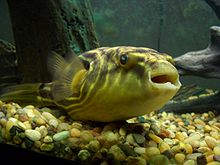Fahaka pufferfish
| Fahaka pufferfish | |
|---|---|

| |
| Scientific classification | |
| Domain: | Eukaryota |
| Kingdom: | Animalia |
| Phylum: | Chordata |
| Class: | Actinopterygii |
| Order: | Tetraodontiformes |
| Family: | Tetraodontidae |
| Genus: | Tetraodon |
| Species: | T. lineatus
|
| Binomial name | |
| Tetraodon lineatus | |
The fahaka pufferfish (from Arabic: فهقة), also known as the Nile puffer, globe fish, lineatus puffer (Tetraodon lineatus), is a tropical freshwater pufferfish found in the upper Nile, Chad, Senegal, Gambia, Geba, Volta and Turkana basins in West, Northeast and East Africa.[1][2]
Characteristics
[edit]
Fahaka pufferfish can reach up to 43 cm (1.4 ft) in length.[2] They have the ability to inflate when threatened and, like many puffers, carry the toxin tetrodotoxin.[2]
Fahaka pufferfish, like other molluscivores, feed mainly on benthic organisms which may include freshwater mussels and snails.[2] They are typically found in large rivers, open water, weed beds and vegetated fringes.[2]
In the River Nile, the recorded average lifespans of Fahaka pufferfish have measured about five years.[3]
Researchers AbouelFadl and Farrag have measured the gonadosomatic index of the Fahaka pufferfish to increase from April to August. They have interpreted these readings to suggest a spawning season during this period.[3]
Gallery
[edit]-
Inflated, Ethiopia
-
1907 illustration
References
[edit]- ^ a b Akinyi, E.; Azeroual, A.; Bousso, T.; Getahun, A. & Lalèyè, P. (2010). "Tetraodon lineatus". The IUCN Red List of Threatened Species. 2010. IUCN: e.T181807A7740095. doi:10.2305/IUCN.UK.2010-3.RLTS.T181807A7740095.en. Retrieved 14 January 2018.
- ^ a b c d e Froese, Rainer; Pauly, Daniel (eds.). "Tetraodon lineatus". FishBase. January 2017 version.
- ^ a b AbouelFadl, Khaled; Farrag, Mahmoud M.S. (2021). "Biology and population dynamics of the freshwater puffer fish, Tetraodon lineatus (Linnaeus, 1758), from the River Nile, Aswan, Egypt". Egyptian Journal of Aquatic Research. 47 (1): 75–80. doi:10.1016/j.ejar.2020.09.005 – via Elsevier Science Direct.




